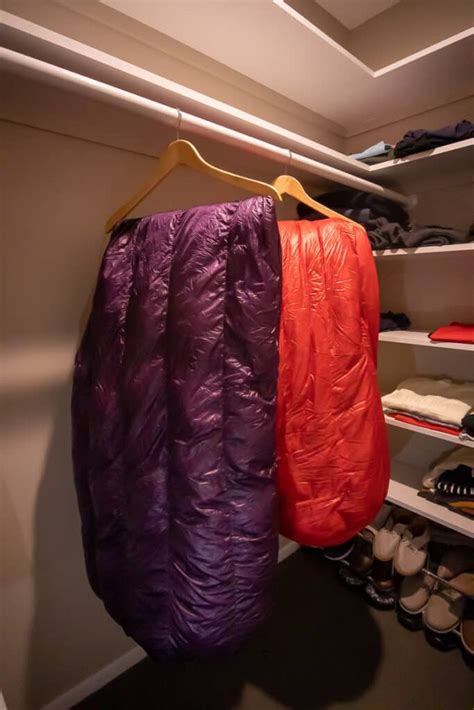How to Store Sleeping Bags: A Comprehensive Guide
How Should I Store My Sleeping Bag?
Storing your sleeping bag properly is crucial to maintaining its
performance and extending its lifespan. Improper storage can lead to damage
like mildew, moisture buildup, and deterioration of the insulation. Here’s a
comprehensive guide on how to store your sleeping bag correctly:
1. Clean Your Sleeping Bag Before Storing
Before storing your sleeping bag, it’s essential to clean it thoroughly. This
removes any dirt, grime, sweat, or body oils that can attract moisture and
promote the growth of mildew. Check the care instructions on your sleeping bag
label for specific washing and drying recommendations.
2. Allow Your Sleeping Bag to Dry Completely
After cleaning, ensure your sleeping bag is completely dry before storing it.
Even a slightly damp sleeping bag can develop mildew over time. Hang it
outside in a well-ventilated area or use a low-heat setting on your dryer if
allowed by the manufacturer.
3. Choose a Storage Method
There are several methods for storing sleeping bags, each with its pros and
cons:
- Storage Bag: The original bag your sleeping bag came
in is usually a good choice. It’s often made of breathable material and helps
compress the bag for compact storage. -
Vacuum-Sealed Bags: These bags can further compress your
sleeping bag, saving space, but they can trap moisture and potentially
damage the down insulation. Use them sparingly and only on dry bags. -
Mesh Storage Bag: A mesh bag allows for better airflow,
which is beneficial for storing sleeping bags long-term.
4. Store in a Cool, Dry Place
The ideal storage environment for a sleeping bag is cool, dry, and dark. Avoid
storing it in damp areas like attics or basements, which can lead to moisture
problems. A closet or a storage bin in a dry, well-ventilated room is a good
option.
5. Avoid Compression for Long-Term Storage
While compression is helpful for travel, long-term storage in a compressed
state can damage the insulation of your sleeping bag. If storing it for an
extended period, try to keep it loose and uncompressed.
6. Periodically Check and Air Out
Even when stored properly, it’s a good practice to check on your sleeping bag
periodically, especially if you’re storing it for a long time. Air it out
occasionally by hanging it in a well-ventilated area to prevent moisture
buildup.
7. Store with a Moth Repellent (Optional)
If you’re storing your sleeping bag for a long time, consider using a moth
repellent. This will help prevent any potential damage from moths.
Can I Store My Sleeping Bag in a Stuff Sack?
Storing your sleeping bag in a stuff sack is generally not recommended for
long-term storage. Stuff sacks are designed for compressing the bag for
travel, but they can trap moisture and put pressure on the insulation,
leading to damage.
If you’re storing your sleeping bag in a stuff sack, it’s essential to ensure
it’s completely dry before doing so. Ideally, choose a breathable stuff sack
that allows for some airflow.
For extended storage, it’s best to store your sleeping bag in a larger,
more breathable storage bag or a mesh bag, as discussed in the previous
section.
How Long Can I Store My Sleeping Bag Without Cleaning It?
There’s no set timeline for how long you can store a sleeping bag without
cleaning it. It depends on several factors, including how frequently you use
it, how much you sweat during use, and the type of insulation.
However, it’s generally recommended to clean your sleeping bag at least once
a year, even if you haven’t used it extensively. Cleaning helps remove any
dirt, sweat, and oils that can attract moisture and promote mildew growth.
If you use your sleeping bag frequently, especially in hot or humid conditions,
you might need to clean it more often.
Is It Okay to Store My Sleeping Bag in a Plastic Container?
Storing your sleeping bag in a plastic container is not recommended for
long-term storage. Plastic containers can trap moisture, creating a breeding
ground for mildew and potentially damaging your sleeping bag.
If you’re using a plastic container for short-term storage, make sure the
sleeping bag is completely dry before placing it inside and allow for some
airflow. It’s best to avoid using plastic containers altogether for long-term
storage and opt for a breathable material like cotton or mesh.
How Should I Store My Sleeping Bag in a Backpack?
Storing your sleeping bag in a backpack for travel is a common practice.
However, it’s crucial to ensure the bag is dry and properly compressed to
avoid damage.
Here’s a step-by-step guide on how to store your sleeping bag in a backpack:
-
Clean and Dry: Ensure your sleeping bag is clean and
completely dry before packing it. -
Compression: Use your sleeping bag’s stuff sack to compress
it to a manageable size. -
Placement: Place the compressed sleeping bag in the bottom
of your backpack, where it’s least likely to be crushed or exposed to
moisture. -
Protection: Consider placing the sleeping bag in a dry bag
or waterproof liner for extra protection against moisture. -
Pack Other Items: Pack heavier items at the bottom of the
backpack and lighter items on top to ensure weight distribution and
stability.
How Should I Store My Down Sleeping Bag?
Down sleeping bags require special care and storage to maintain their loft
and insulation properties.
Here are some tips for storing down sleeping bags:
-
Clean Thoroughly: Down sleeping bags need regular cleaning
to maintain their loft and performance. Use a specialized down cleaner and
follow the manufacturer’s instructions carefully. -
Avoid Compression: Long-term storage in a compressed state
can damage down insulation, reducing its ability to loft and trap heat.
Store your down sleeping bag loosely in a breathable bag or container. -
Breathable Storage: Choose a storage bag made from
breathable material like cotton or mesh to allow for airflow and prevent
moisture buildup. -
Store in a Cool, Dry Place: Avoid storing your down
sleeping bag in damp areas like attics or basements. A closet or a storage
bin in a dry, well-ventilated room is a good option.
How Should I Store My Synthetic Sleeping Bag?
Synthetic sleeping bags are generally more durable and easier to care for
than down sleeping bags. However, they still require proper storage to
maintain their performance.
Here are some tips for storing synthetic sleeping bags:
-
Clean Regularly: Wash your synthetic sleeping bag regularly
according to the manufacturer’s instructions to remove dirt, sweat, and
oils. -
Allow to Dry Completely: Ensure the sleeping bag is
completely dry before storing it to prevent mildew growth. -
Breathable Storage: Store your synthetic sleeping bag in a
breathable bag or container to allow for airflow. -
Cool, Dry Place: Store the bag in a cool, dry, and
well-ventilated area, away from direct sunlight or heat sources.
How Do I Know When It’s Time to Replace My Sleeping Bag?
Sleeping bags have a lifespan, and eventually, they’ll need to be replaced.
Here are some signs that indicate it’s time to get a new sleeping bag:
-
Deterioration: If the insulation is clumping, the fabric is
torn or ripped, or the zippers are malfunctioning, it’s time to replace
the sleeping bag. -
Loss of Loft: If the sleeping bag no longer puffs up to its
original loft, it’s likely losing its insulation properties and may no
longer provide adequate warmth. -
Moisture Buildup: If the sleeping bag retains moisture for
an extended period or has a musty smell, it’s a sign of mildew growth,
indicating a need for replacement. -
Uncomfortable or Ineffective: If you find the sleeping bag
uncomfortable or no longer provides the warmth you need, it’s time to
consider a new one.
How to Make Your Sleeping Bag Last Longer
Following these tips can help extend the lifespan of your sleeping bag:
-
Clean Regularly: Wash your sleeping bag according to the
manufacturer’s instructions to remove dirt, sweat, and oils. -
Dry Thoroughly: Ensure the sleeping bag is completely dry
before storing it. -
Store Properly: Store your sleeping bag in a breathable
bag or container in a cool, dry place. -
Avoid Compression: Avoid storing the sleeping bag in a
compressed state for extended periods. -
Patch Tears and Repairs: Repair any tears or rips in the
fabric as soon as possible. -
Follow Manufacturer’s Instructions: Always follow the
manufacturer’s instructions for cleaning and storing your sleeping bag.
Storing Sleeping Bags: A Summary
| Type of Sleeping Bag | Storage Recommendations |
|---|---|
| Down Sleeping Bag |
Clean thoroughly, avoid compression, breathable storage, cool and dry place. |
| Synthetic Sleeping Bag |
Clean regularly, dry completely, breathable storage, cool and dry place. |
| All Sleeping Bags |
Store in a dry, well-ventilated area, avoid plastic containers, check periodically. |
FAQ: Storing Sleeping Bags
What happens if I store my sleeping bag in a damp place?
Storing your sleeping bag in a damp place can lead to mildew growth. Mildew is
a type of fungus that thrives in moist environments and can damage the
insulation and fabric of your sleeping bag, making it unusable.
Can I store my sleeping bag in a vacuum-sealed bag for a long time?
While vacuum-sealed bags are great for compressing your sleeping bag for
travel, it’s not recommended for long-term storage. Vacuum-sealed bags can
trap moisture and potentially damage the down insulation, especially if the
bag is not completely dry.
What’s the best way to store my sleeping bag for the summer months?
The best way to store your sleeping bag for the summer months is in a cool,
dry, and well-ventilated place. Ensure it’s clean and completely dry before
storing it. A closet or a storage bin in a dry room is a good option.
How can I prevent my sleeping bag from getting smelly?
Regular cleaning is essential to prevent your sleeping bag from getting
smelly. Wash it according to the manufacturer’s instructions after each use or
at least once a year.
What are the signs that my sleeping bag needs to be replaced?
Signs that your sleeping bag needs to be replaced include:
- Deterioration of insulation or fabric.
- Loss of loft.
- Moisture buildup and mildew growth.
- Ineffectiveness or discomfort.
Can I use a dryer to dry my sleeping bag?
Whether you can use a dryer to dry your sleeping bag depends on the
manufacturer’s instructions. Some sleeping bags are safe to dry on a low-heat
setting, while others recommend air drying.
Is it okay to store my sleeping bag in a stuff sack for a long time?
Storing your sleeping bag in a stuff sack for a long time is not
recommended. Stuff sacks are designed for travel, but they can trap
moisture and put pressure on the insulation, potentially causing damage.


